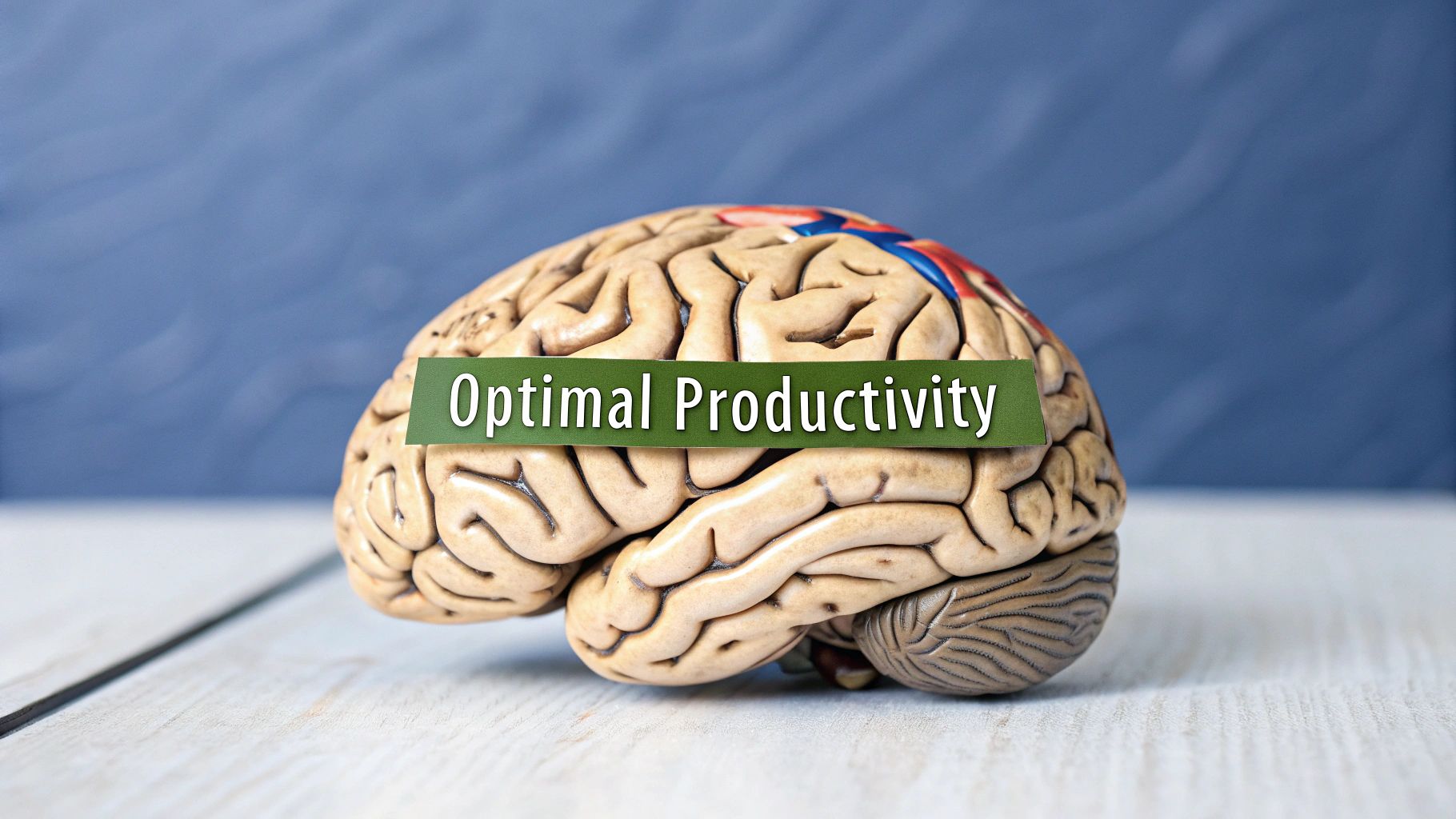If you’ve got ADHD, traditional productivity approaches probably haven’t worked well for you. Trying to “power through” tasks often leads to burnout instead of achievement. That’s where the Pomodoro Technique comes in—a refreshingly different approach that’s remarkably well-suited for ADHD brains. Named after the Italian word for tomato, this method breaks work into manageable chunks with built-in breaks, working with your brain rather than against it.
The technique is beautifully simple: work for 25-minute intervals (called “pomodoros”), take 5-minute breaks, and enjoy a longer 15-30 minute break after completing four work sessions. This rhythm matches how attention naturally fluctuates, preventing mental exhaustion while giving you regular doses of accomplishment. Instead of facing an intimidating three-hour project, you’re tackling just 25 minutes at a time—a much more approachable challenge.
Why Pomodoro Works for ADHD Brains
The Pomodoro Technique clicks with ADHD brains for several key reasons. First, it provides clear structure that helps overcome that paralyzing “where do I even start?” feeling. Breaking down big tasks into timed segments makes them less overwhelming and more doable. Plus, those regular breaks aren’t just nice—they’re essential for recharging your mental batteries.
Consider writing a blog post. Rather than staring at a blank screen for hours feeling stuck, the Pomodoro approach has you focus just on writing for 25 minutes. Then you take a 5-minute break to stretch, grab water, or step outside. This approach dramatically reduces the chances of getting distracted or feeling overwhelmed by the task.
Francesco Cirillo developed this technique back in the late 1980s while trying to improve his study habits during university. He used a tomato-shaped kitchen timer (hence the name), and his method has since become widely recognized for boosting productivity, especially for people with ADHD. Learn more about Pomodoro for ADHD.
Harnessing the Power of Short Breaks
Those short breaks aren’t just a nice bonus—they’re absolutely crucial to making this technique work for ADHD brains. These pauses give you a chance to release built-up energy, reset your focus, and start the next work session with fresh concentration. Each completed pomodoro also gives you a small win, building momentum and making it easier to continue.
You can customize these breaks to fit your specific needs. Some people benefit from physical movement like a quick walk or stretching. Others might prefer quiet moments of reflection or a few minutes of meditation. The important thing is choosing activities that help you reset mentally and physically. This personal touch ensures your breaks truly serve their purpose—helping you return to work energized and ready to focus on the next 25-minute chunk.
The Neuroscience Behind Why Pomodoro Works for ADHD
When it comes to managing ADHD symptoms, the Pomodoro Technique isn’t just another productivity tip—it’s a method that works with your brain’s natural wiring. This technique directly addresses the attention regulation and reward processing challenges that many people with ADHD face daily. Let’s dive into how those 25-minute work intervals can make such a difference for the ADHD brain.
Dopamine and the ADHD Brain
People with ADHD often struggle with dopamine regulation. This important neurotransmitter controls motivation and focus, making it harder to start tasks, maintain attention, and feel rewarded when you accomplish something. This isn’t about lacking willpower—it’s about how your brain is wired.
The Pomodoro Technique offers a brilliant solution with its short, 25-minute work intervals. Each completed “pomodoro” gives your brain a small dopamine boost, creating that satisfying feeling of achievement. This is completely different from traditional long work sessions that can feel overwhelming and actually deplete dopamine levels further.

For those with inattentive ADHD especially, this technique helps maintain productivity by providing regular “wins” throughout the day. The short-term goals create motivation boosts that make a real difference. Learn more about how the Pomodoro Technique supports motivation.
Time Pressure and Focus
Interestingly, the ADHD brain often responds well to short-term time constraints while struggling with long-term deadlines. The Pomodoro Technique’s clearly defined 25-minute work periods create just enough urgency to enhance focus without causing anxiety.
This structured timeframe limits opportunities for distractions and helps channel your energy into the task at hand. You might also be interested in: How a bullet journal can help with ADHD.
Preventing Cognitive Fatigue
Mental exhaustion happens quickly for people with ADHD, who often use more mental energy to stay focused than neurotypical individuals. The regular breaks built into the Pomodoro Technique are essential for preventing burnout.
These short pauses allow your brain to rest and recharge, preserving your mental resources and preventing the frustration that comes with pushing yourself too hard. This approach is much more effective than working until you’re completely drained—a pattern many with ADHD know all too well.
Hyperfocus vs. Pomodoro Sessions
While hyperfocus can be a superpower for some with ADHD, it’s often uncontrolled and can lead to neglecting other important responsibilities. The Pomodoro Technique provides a structured alternative that helps you direct your focus intentionally.
It gives you a framework to channel your concentration into predetermined work periods, preventing hyperfocus from taking over your entire day. This controlled approach allows for better balance in how you spend your time and energy.
The Brain on Breaks
Those short breaks between work sessions aren’t just about resting—they’re actually working magic for your brain. During these pauses, your brain subconsciously processes information, making connections and consolidating what you’ve learned.
These breaks also allow for healthy mind-wandering, which often leads to new ideas and insights that will benefit you when you return to work. This makes the Pomodoro Technique more than just a time management tool—it’s a cognitive enhancer specifically helpful for the ADHD brain.
ADHD Brain Function and Pomodoro Benefits
Below is a comparison of how the ADHD brain typically functions compared to how the Pomodoro Technique addresses these specific challenges. This table shows why this method is particularly effective for people with ADHD.
| ADHD Brain Challenge | How Pomodoro Addresses It | Expected Benefit |
|---|---|---|
| Dopamine deficiency causing motivation issues | Short work intervals provide frequent completion rewards | Increased motivation and sense of accomplishment |
| Difficulty sustaining attention for long periods | Time-limited focus periods with defined endpoints | Improved concentration without overwhelming the brain |
| Time blindness/poor time perception | Visual timer and structured intervals | Better time awareness and management |
| Task initiation struggles | “Just 25 minutes” reduces psychological barrier to starting | Easier to begin difficult or boring tasks |
| Vulnerability to distractions | Commitment to focus only during timed sessions | Fewer interruptions and increased productivity |
| Cognitive fatigue from extended mental effort | Regular, scheduled breaks prevent burnout | Sustainable productivity throughout the day |
| Tendency toward uncontrolled hyperfocus | Structured timing creates boundaries for focus | Balanced attention across multiple priorities |
| Difficulty with task prioritization | Single-task focus during each Pomodoro | Clearer task management and completion |
This structured approach provides the external framework that many ADHD brains benefit from, essentially working with your natural tendencies rather than against them.
Conquering Time Blindness with Strategic Pomodoros
Time blindness is that frustrating ADHD experience where hours seem to vanish without a trace, making even simple tasks feel overwhelming. The good news? The Pomodoro Technique offers a practical solution. This method uses focused work intervals (typically 25 minutes) followed by short breaks to create a concrete framework for time. Rather than seeing time as an elusive concept, you begin to experience it as a helpful structure.
Think about it this way: instead of facing the daunting task of “writing a report” for an unknown period, you focus only on writing for one Pomodoro. Suddenly, an abstract task becomes a concrete, measurable unit of work. After each interval, your short break provides a chance to refresh before tackling the next session.
This approach works particularly well for people with ADHD, who often struggle with conventional time management methods. By breaking work into these manageable chunks, you can better perceive time and organize tasks more efficiently. The technique helps fight procrastination and improves time awareness, making it easier to judge how long tasks will actually take. It essentially flips time from an abstract concept into a tangible measure of productivity, allowing you to focus on making steady progress. Discover more insights about the Pomodoro Technique and ADHD here.
Visualizing Time: From Abstract to Concrete

Visual timers play a key role in making time more concrete for people with ADHD. When you can actually see time ticking away on a physical or digital timer, it transforms from an abstract idea into something visible and manageable. This helps you develop a stronger sense of how long tasks actually take, improving your ability to plan future projects more accurately.
This approach can be especially helpful when fighting procrastination. You might also want to check out How to Avoid Procrastination.
Some people with ADHD find it helpful to create physical representations of time. For example, you could use a stack of sticky notes to represent each Pomodoro needed for a project. As you complete each interval, you remove a note, giving yourself a visual sense of accomplishment and progress.
Choosing the Right Timer
Finding the right timer is crucial for making the Pomodoro Technique work with ADHD. Be careful – a timer that’s too visually busy or complicated can become a distraction itself. Try different options to see what fits your style. This might be a simple kitchen timer, a dedicated Pomodoro app, or a visual timer on your computer screen.
Consider features like customizable sounds, visual indicators, and how it might work with your other productivity tools. The key is finding a timer that supports your focus, not one that distracts from it.
The perfect timer strikes that balance between functionality and simplicity, maximizing the benefits of the Pomodoro Technique for your unique ADHD brain.
Implementing Pomodoro for ADHD Success: Your Blueprint
The Pomodoro Technique can be a game-changer for ADHD brains, but it needs some customization to really shine. In this section, I’ll walk you through how to take this time management method from concept to daily practice. We’ll explore everything from creating the right environment to adapting the technique for both hyperfocus days and low-motivation slumps.
Setting the Stage for Success
Before you jump into your first Pomodoro session, a bit of preparation will set you up for success. Find a dedicated workspace that works for you—whether it’s a specific desk at home or your favorite corner in a coffee shop. Minimize distractions by turning off notifications and letting others know you’re in focus mode. Gather everything you’ll need beforehand (notebooks, pens, water, chargers) so you won’t need to interrupt your flow once you’ve started. This initial setup makes a huge difference in creating an environment where your ADHD brain can focus.
Choosing the Right Tasks
For folks with ADHD, task selection can make or break your Pomodoro success. Start with tasks that match your current energy level and interest. If your brain feels foggy, pick something straightforward and routine. If you’re feeling energized, tackle that challenging project you’ve been putting off. This approach helps you work with your natural brain rhythms instead of fighting against them.
Mastering the Pomodoro Workflow
The heart of the technique is its structured time blocks: 25 minutes of focused work followed by a 5-minute break. After completing four Pomodoros, reward yourself with a longer break of 15-30 minutes. This rhythm gives your brain regular chances to rest and recharge, preventing burnout. For those of us who struggle with traditional time management, these clear boundaries provide a helpful framework that makes time feel more concrete.
Handling Interruptions and Transitions
Let’s be real—interruptions happen. When someone interrupts your Pomodoro, quickly jot down what you need to remember and get back to your task. If something truly needs immediate attention, pause your timer and handle it, then start a fresh Pomodoro when you return. The transitions between work sessions and breaks are equally important. Use your short breaks for activities that genuinely refresh you—stretch, breathe deeply, or take a quick walk. Avoid checking social media or email, as these can easily turn a 5-minute break into a 30-minute distraction.
Adapting to Hyperfocus and Low Motivation
One of the best things about the Pomodoro Technique is its flexibility. If you find yourself in hyperfocus mode and making great progress when the timer rings, it’s okay to extend your session a bit. Just be mindful not to push too long and risk burnout. On the flip side, if you’re struggling to get started, try a mini-Pomodoro of just 15 minutes. This smaller commitment feels much less intimidating and can help you build momentum. Check out our guide on How to master your bullet journal for more time management strategies that pair well with Pomodoro.
Creating a Sustainable Routine
Consistency is crucial for making the Pomodoro Technique work long-term. Try to schedule specific times for your Pomodoro sessions each day. While structure helps, it also embraces flexibility—especially important for ADHD brains. Don’t hesitate to adjust the length of your work periods or breaks based on your needs and energy levels. This balance between routine and adaptability ensures your Pomodoro practice remains helpful, not restrictive.
Below, I’ve put together a practical guide that breaks down how to tailor the Pomodoro Technique specifically for different ADHD needs:
Pomodoro Technique Setup Guide for ADHD
| Implementation Step | Standard Approach | ADHD-Specific Adaptation | Why It Works |
|---|---|---|---|
| Task Selection | Choose any task. | Prioritize tasks based on energy levels and interest. Start with easier tasks if feeling mentally fatigued. | Reduces overwhelm and increases likelihood of completing the Pomodoro. |
| Workspace Setup | Find a quiet space. | Minimize distractions by removing visual clutter, silencing notifications, and using noise-canceling headphones. | Creates an environment conducive to focused work. |
| Timer Selection | Use a simple timer. | Choose a visual timer with customizable sounds and alerts. | Makes time tangible and less abstract, improving time awareness. |
| Break Activities | Take short breaks. | Engage in activities that promote mental and physical restoration, such as stretching, deep breathing, or a short walk. | Prevents cognitive fatigue and enhances focus for subsequent Pomodoros. |
| Interruption Handling | Briefly note interruptions. | If the interruption requires immediate attention, stop the timer and address it. Restart a new Pomodoro once refocused. | Maintains the integrity of the Pomodoro and prevents fragmented attention. |
| Hyperfocus Management | Stick to the 25-minute interval. | If deep in productive hyperfocus, extend the Pomodoro slightly, but ensure a break is eventually taken to avoid burnout. | Capitalizes on hyperfocus while preventing the risk of overexertion. |
| Low Motivation Strategy | Start a new Pomodoro. | Shorten the first Pomodoro to 15 minutes to make the task seem less daunting. | Overcomes initial inertia and builds momentum. |

Personalizing Pomodoro for Your Unique ADHD Profile
The standard Pomodoro Technique—25 minutes of work followed by a 5-minute break—is a fantastic starting point. But let’s face it: ADHD brains come in all shapes and sizes, and what works brilliantly for one person might fall flat for another. Making this technique truly yours is the secret to getting the most out of it. This means understanding your specific ADHD type—inattentive, hyperactive-impulsive, or combined—and tweaking the method to match.
Tailoring Pomodoro to Your ADHD Presentation
If you have inattentive ADHD, focusing for long periods is probably your biggest hurdle. Try shorter Pomodoro sessions of about 15 minutes with 3-minute breaks instead of the classic 25-minute blocks. These more frequent mental resets can prevent that overwhelming feeling that comes with longer work sessions.
You might be interested in: How to master a 5 am morning routine.
For those with hyperactive-impulsive ADHD, movement during breaks isn’t just helpful—it’s essential! Jump up and do some jumping jacks, take a quick walk around your space, or do some simple stretches. These physical activities help channel your excess energy so you can focus better when you get back to work. You might also benefit from longer breaks after completing several Pomodoros.
If you have combined type ADHD, mix and match strategies. Play around with different session lengths and break activities to find what helps you both stay focused and manage your energy. There’s some trial and error involved, but finding your perfect balance is absolutely worth it.
Finding Your Optimal Intervals
Discovering your ideal Pomodoro timing is a personal journey. Start with the traditional 25/5 split, then experiment. Maybe 15-minute or even 10-minute work periods work better for your brain. Break times need customization too—some ADHD minds do best with short, active breaks, while others need longer to reset. Keep track of how productive and energetic you feel with different interval combinations to find your sweet spot.
Innovative Adaptations for ADHD Success
Beyond tweaking your timing, consider other helpful modifications. If you process information visually, try using visual enhancements like colorful timers or progress trackers that make your work sessions more engaging. Need external motivation? Find an accountability partner who can check in with you after each Pomodoro or set shared goals to boost both your productivity levels.
The Pomodoro Technique works differently for everyone with ADHD—some find the timed intervals distracting while others find them incredibly helpful, especially when combined with strategies like limiting distractions and breaking down big tasks. Explore this topic further.
Building Your Personalized Pomodoro System
Creating a Pomodoro system that works with your unique ADHD brain isn’t about following rigid rules—it’s about finding structured flexibility. Try different combinations of work intervals, break activities, and supporting strategies. Pay attention to what best supports your focus, energy levels, and overall productivity. Your goal is to develop a sustainable practice that works with your brain rather than against it, boosting both your efficiency and well-being. This personalized approach transforms the Pomodoro Technique from a generic productivity hack into a powerful tool for long-term ADHD success.
Digital Allies: Tech Tools That Supercharge ADHD Pomodoros
The Pomodoro Technique offers a powerful framework for managing ADHD challenges through its structured work intervals and short breaks. It’s especially helpful for addressing time blindness and focus issues. When paired with the right digital tools, this technique becomes even more effective for people with ADHD.
Let’s explore how specific apps and technology can become genuine partners in your ADHD Pomodoro practice.
Finding the Right Tech for Your ADHD Brain
Every ADHD brain is unique, and what works brilliantly for one person might be overwhelming for another. The key is finding tools that complement your specific needs without adding extra mental burden.
Look for apps with features like visual timers that make time more concrete, reward systems that tap into your brain’s motivation pathways, and distraction blockers that help create a truly focused environment. Taking time to find your personal tech match will significantly improve your Pomodoro experience.
Free vs. Premium: What’s Worth the Investment?
Many excellent Pomodoro timer apps cost nothing, providing basic features that work perfectly for beginners. However, some paid features can be game-changers for ADHD users, including customizable timer lengths, detailed progress tracking, ambient sound options, and advanced reporting.
Think about which premium features actually address your specific ADHD challenges. Sometimes, a small investment in the right tool can lead to huge improvements in your productivity and focus over time.
Integrating Tech Seamlessly into Your Workflow
Adding new technology shouldn’t create extra hurdles in your day. Choose apps that fit naturally with what you’re already using – whether that’s your calendar, task manager, or note-taking system.
The goal is for these digital tools to enhance your Pomodoro practice, not become another source of distraction or frustration. A smooth integration process is essential for sticking with any new system long-term. Read also: How to master the psychology of winning.
Recommended Tech Tools for ADHD Pomodoros
Here’s a comparison of some popular options, highlighting their key features and benefits:
| App Name | Free/Premium | Key Features | ADHD Benefits |
|---|---|---|---|
| Forest | Premium | Visual timer, rewards system, distraction blocker | Gamifies focus, provides motivation, reduces distractions |
| Focus To-Do | Free/Premium | Pomodoro timer, task management, cross-platform | Streamlines workflow, improves organization |
| PomoDoneApp | Free/Premium | Integrates with other task managers | Enhances existing systems, reduces switching costs |
| Be Focused Pro | Premium | Customizable intervals, detailed reporting | Personalized timing, tracks progress effectively |
| Tide | Free/Premium | Ambient sounds, focus timer | Creates calming environment, improves concentration |

The Power of Distraction Blockers
One of the most helpful features for ADHD users is the ability to block distractions. These tools can temporarily restrict access to websites or apps that commonly derail your focus, such as social media platforms or email.
During your focused Pomodoro sessions, minimizing these digital temptations creates a dedicated space for deep work. This simple barrier can dramatically increase your productivity by preventing the constant pull of notifications and dopamine-triggering sites.
The Sweet Spot: Technology as an Ally, Not a Distraction
Technology should boost your Pomodoro practice, not complicate it. Try different apps and features to discover what works best with your unique ADHD brain.
The ultimate goal is finding that perfect balance where the technique and technology work together seamlessly, helping you maximize focus, productivity, and overall well-being. With some experimentation, your digital tools can become true allies on your ADHD Pomodoro journey.
Beyond Pomodoro: Creating Your Complete ADHD Strategy
While the Pomodoro Technique provides a helpful framework for managing ADHD challenges, it’s just one piece of a larger productivity puzzle. Think of it as a cornerstone – valuable on its own, but even more powerful when combined with other approaches. Let’s explore how you can build a complete system that plays to your strengths and addresses your specific needs.
Amplifying Accountability and Focus
Body doubling – working alongside someone else – can significantly boost your Pomodoro sessions. Having another person present (virtually or in person) creates natural accountability that makes it harder to get sidetracked. This shared focus makes even tedious tasks feel more approachable. For example, joining a virtual coworking session during your Pomodoros adds that gentle pressure that keeps many of us on track.
Your physical environment matters too. Consider using noise-canceling headphones, clearing clutter from your workspace, or setting clear boundaries with family members during your focus periods. Creating a dedicated “focus zone” sends a powerful signal to your brain that it’s time for concentrated work.
Strategic Medication Timing and Task Prioritization
If you take ADHD medication, aligning your doses with your Pomodoro sessions can enhance your focus and productivity. Talk with your doctor about this approach to find what works best for your specific needs and medication schedule. This thoughtful coordination helps you make the most of both your medication and time management techniques.
Before starting your Pomodoros, use a method like the Eisenhower Matrix to identify which tasks truly deserve your attention. This simple urgent/important framework helps ensure you’re spending your valuable focus time on activities that actually matter – not just busy work that feels productive.
Emotional Regulation and Sustainable Habits
ADHD often involves challenges with emotional regulation, which directly impacts motivation and focus. Try incorporating quick mindfulness or deep breathing exercises into your Pomodoro breaks. These moments become opportunities to reset emotionally before diving back into your next work session.
Remember that building sustainable habits takes time and experimentation. Don’t get discouraged if you miss some Pomodoros or need to adjust your system along the way. Be kind to yourself and view this as an ongoing process of discovery. The goal isn’t perfection – it’s creating a system that works with your brain’s natural patterns and supports your overall wellbeing.
Building Your Personalized Productivity Ecosystem
These complementary strategies create a supportive ecosystem for your Pomodoro practice. Each element reinforces the others, forming a cohesive approach to managing ADHD:
- Body Doubling: Creates accountability and reduces distractions
- Environmental Modifications: Establishes a dedicated focus zone
- Medication Timing (if applicable): Aligns treatment with performance needs
- Task Prioritization: Ensures focused work on high-impact activities
- Emotional Regulation: Manages mood fluctuations for sustained focus
- Habit Building: Creates sustainable routines that allow flexibility
This integrated approach lets you build a truly personalized system that supports both productivity and wellbeing. By tackling multiple ADHD challenges at once, you’ll likely accomplish more while feeling a greater sense of control and satisfaction.
Ready to build a website that supports your entrepreneurial journey, especially if you have ADD? Lorelei Web provides a wealth of resources on productivity, business management, and content marketing tailored to the unique challenges and strengths of entrepreneurs with ADD. Learn more about Lorelei Web and start building your dream today!

Lorelei has been an online entrepreneur, marketer and writer since 2006. Her biggest passion is WordPress, which is why she switched to being a full-time blogger 20 years ago and hasn’t looked back since. With so many years of experience behind her, she is an expert in copywriting, SEO, marketing and business strategies.






